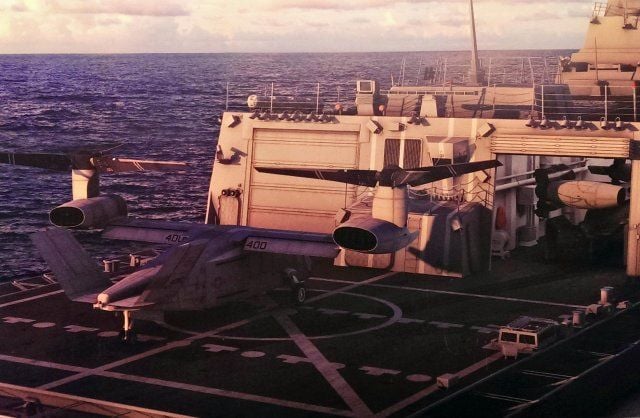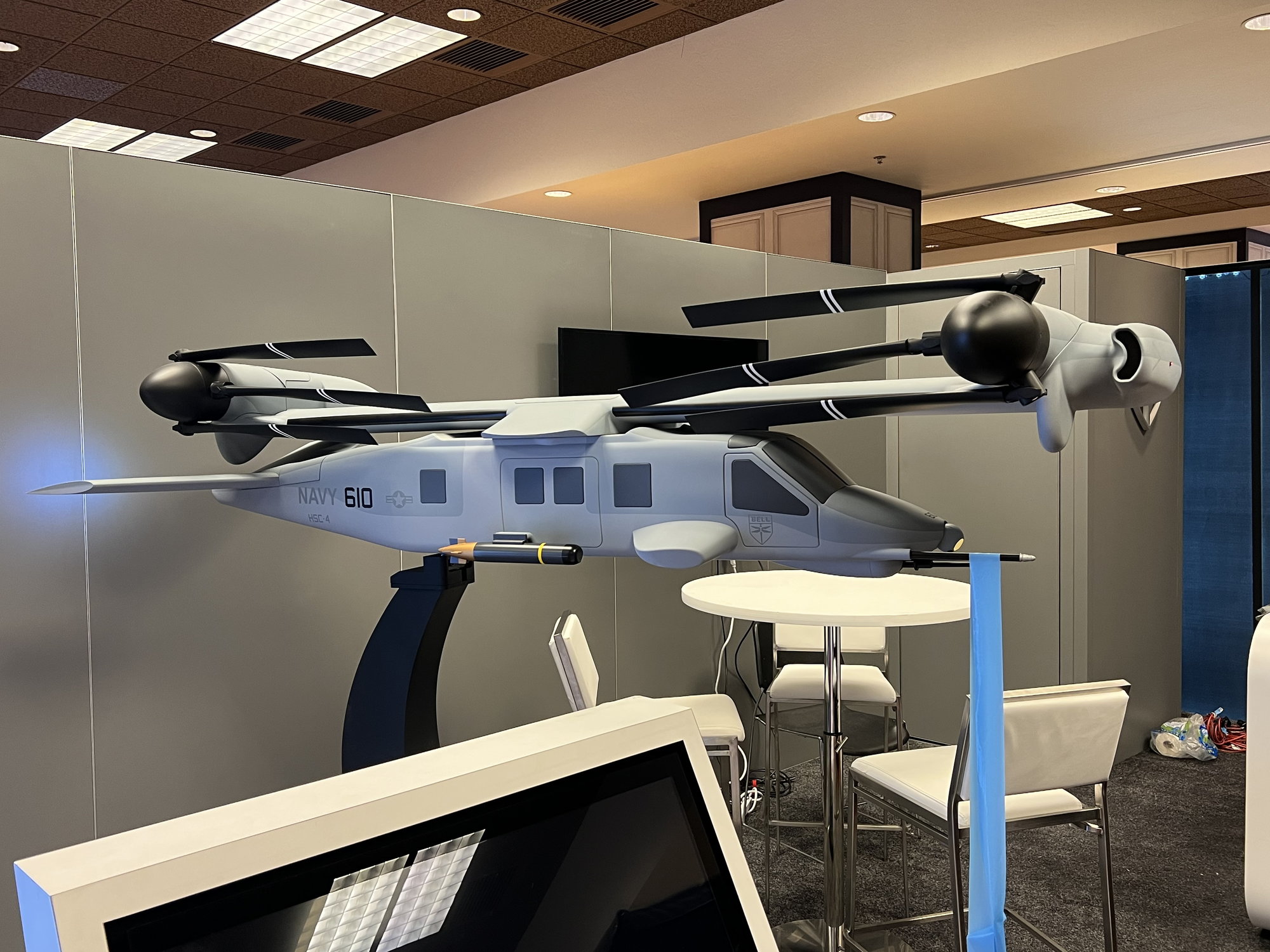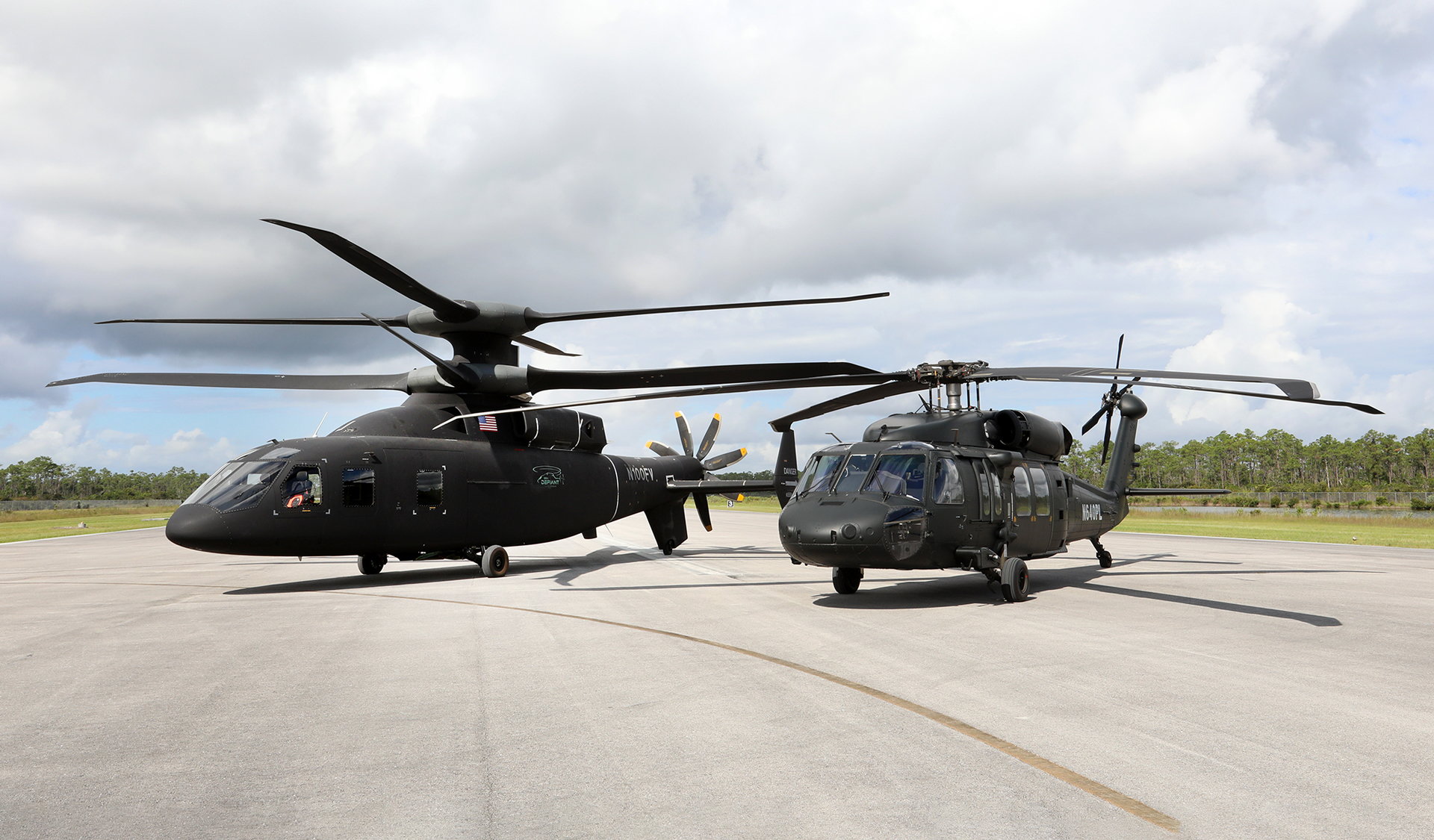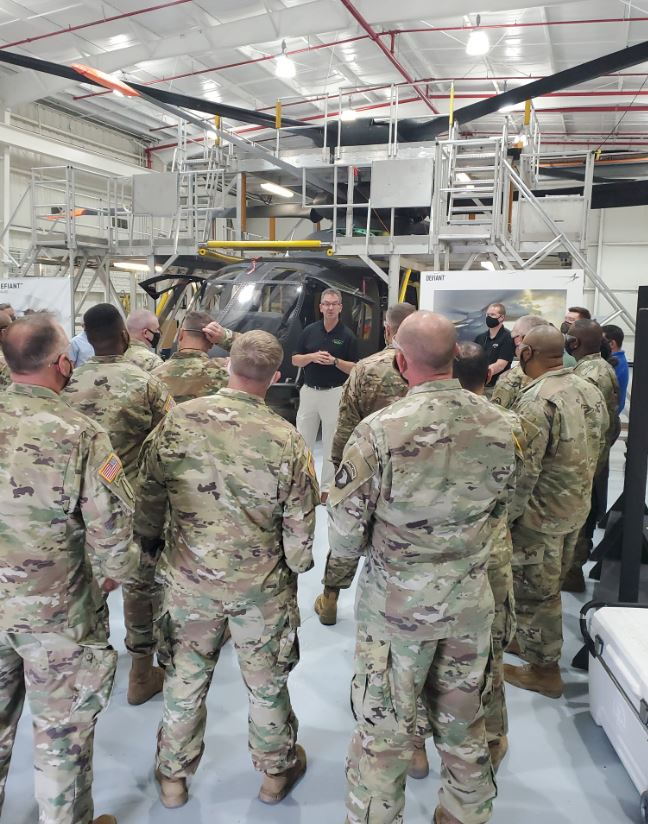V-280 wins US ARMY FLRAA contract
For some reason I can't get multi quote to work. In any case, Bell had designed in the option for folding for a naval variant from the start of the V280 program and that work may have even preceded V247. They wanted it to be able to operate from shipboard hangars that can accommodate an H-60. Folded up, they say a V280 would occupy the same cubic "box" as a folded UH-1Y.


The following users liked this post:


The following users liked this post:
SASless:
I would say it's not relevant as to what the V280's (or SB>1's) helicopter performance actually is compared to the Black Hawk. Army is not asking for another Black Hawk, any more than the Army was asking for another Huey when it ran the UTTAS competition. The question is how well the V280 will perform the Army's FLRAA mission. It's the mission that's relevant. If you want to do apple to apple comparisons that's where you do them and there the Black Hawk fails completely. That's not a fault of the H-60 series, never in the designers' wildest dreams would they expect their craft to be capable of that.
I would say it's not relevant as to what the V280's (or SB>1's) helicopter performance actually is compared to the Black Hawk. Army is not asking for another Black Hawk, any more than the Army was asking for another Huey when it ran the UTTAS competition. The question is how well the V280 will perform the Army's FLRAA mission. It's the mission that's relevant. If you want to do apple to apple comparisons that's where you do them and there the Black Hawk fails completely. That's not a fault of the H-60 series, never in the designers' wildest dreams would they expect their craft to be capable of that.
SASless,
No, this is the correct response. Tiltrotors are not helicopters. Just like a Corvette will not haul a half ton of cargo, or a 8 x 4 sheet of plywood, a truck cannot go 0-60 in 4 sec, or pull one G in a corner.
There are some missions where the aircraft capabilities overlap, and because of the V-280 increased size and power, the V-280 matches the and lift capability of a Blackhawk. But again, why would you want to waste a expensive asset like a tilt rotor to do a cargo job that can be done cheaper by a conventional Helicopter?
Increased speed and range requirements drive design compromises. However, the V280 achieved the performance specifications required by the US Army, and exceeded others like range and speed.
I did not say the V280 is replacing the Blackhawk, that quote was made by press trying to get a story line. I said that the Blackhawk would continue in the fleet, performing roles where it is better suited to its capabilities.
If I came across as harsh, it comes from decades of responding to people who regurgitate what they read or see online from clearly biased sources. Just a few minutes doing research today allows an individual in most cases to determine what is true and what is false.
Back in the 80s, I was working on the F/A-18 Hornet. In the early days of the F/A-18 program we had to continuously respond to criticism that the aircraft did not match the payload of an A-6, or the speed of an F-14.
Recently, when the V-22 was selected by the Navy for the COD mission, similar criticism was leveled.
Note: A tiltrotor is not a fixed wing aircraft either.
No, this is the correct response. Tiltrotors are not helicopters. Just like a Corvette will not haul a half ton of cargo, or a 8 x 4 sheet of plywood, a truck cannot go 0-60 in 4 sec, or pull one G in a corner.
There are some missions where the aircraft capabilities overlap, and because of the V-280 increased size and power, the V-280 matches the and lift capability of a Blackhawk. But again, why would you want to waste a expensive asset like a tilt rotor to do a cargo job that can be done cheaper by a conventional Helicopter?
Increased speed and range requirements drive design compromises. However, the V280 achieved the performance specifications required by the US Army, and exceeded others like range and speed.
I did not say the V280 is replacing the Blackhawk, that quote was made by press trying to get a story line. I said that the Blackhawk would continue in the fleet, performing roles where it is better suited to its capabilities.
If I came across as harsh, it comes from decades of responding to people who regurgitate what they read or see online from clearly biased sources. Just a few minutes doing research today allows an individual in most cases to determine what is true and what is false.
Back in the 80s, I was working on the F/A-18 Hornet. In the early days of the F/A-18 program we had to continuously respond to criticism that the aircraft did not match the payload of an A-6, or the speed of an F-14.
Recently, when the V-22 was selected by the Navy for the COD mission, similar criticism was leveled.
Note: A tiltrotor is not a fixed wing aircraft either.
Admikar
Where do you get that the V-280 can’t take off and land like a helicopter? It’s hover envelope exceeds that of a UH-60 and it met all of the “helicopter” mode maneuverability requirements in the FLRAA spec. Having witnessed V-280 demos low speed maneuverability is not an issue. As to decel/accel the 280 can tilt the rotors past 90 to rapidly decel with a level fuselage, and when it wants to depart the rotors tilt forward and it is gone (very Airwolf-ish).
it is the close stacked coax config of the X-2 technology which has maneuverability issues. Despite stating the rotors are so stiff they can never collide under any circumstance, the S-97 demonstrated this was a lie when the rotors on the S-97 collided while in a hover during computer induced roll reversals which occurred at rates less than expected in aggressive flight maneuvers. That incident exposed the fatal flaw of the ABC for all to see.
Where do you get that the V-280 can’t take off and land like a helicopter? It’s hover envelope exceeds that of a UH-60 and it met all of the “helicopter” mode maneuverability requirements in the FLRAA spec. Having witnessed V-280 demos low speed maneuverability is not an issue. As to decel/accel the 280 can tilt the rotors past 90 to rapidly decel with a level fuselage, and when it wants to depart the rotors tilt forward and it is gone (very Airwolf-ish).
it is the close stacked coax config of the X-2 technology which has maneuverability issues. Despite stating the rotors are so stiff they can never collide under any circumstance, the S-97 demonstrated this was a lie when the rotors on the S-97 collided while in a hover during computer induced roll reversals which occurred at rates less than expected in aggressive flight maneuvers. That incident exposed the fatal flaw of the ABC for all to see.
The following users liked this post:
Read the last part of my second sentence from the post you responded to. Or maybe even better, read whole second sentence. And than let it sink.
If there is only one existing operational tiltrotor, that's what we will use as a measuring tool.
And I never said that V-280 can't do those things ( what I said in aforementioned post was more of making a point than stating a fact). And my post was in response to CTR who asked "why do tiltrotor bashers always compare it with conventional helicopter? It's so much faster, but if it needs to hover, we'll disregard that part of comparison." If it can hover, great, it will be worthy successor. And we just asked if it can hover as good as a conventional helicopter, we never said that it can't.
If there is only one existing operational tiltrotor, that's what we will use as a measuring tool.
And I never said that V-280 can't do those things ( what I said in aforementioned post was more of making a point than stating a fact). And my post was in response to CTR who asked "why do tiltrotor bashers always compare it with conventional helicopter? It's so much faster, but if it needs to hover, we'll disregard that part of comparison." If it can hover, great, it will be worthy successor. And we just asked if it can hover as good as a conventional helicopter, we never said that it can't.
Measuring Tool
Read the last part of my second sentence from the post you responded to……If there is only one existing operational tiltrotor, that's what we will use as a measuring tool…….And my post was in response to CTR who asked "why do tiltrotor bashers always compare it with conventional helicopter?….
The one “operational” Tiltrotor you are referring (V-22) has flown over 700,000 flight hours in combat and severe environments. The smaller 609 commercial Tiltrotor in development has accumulated over 2,000 flight hours and with proportionally bigger rotors than the V-22 has proven safe autorotation landing. The XV-15 Tiltrotor that first flew in 1977 accumulated over 500 flight hours, and now resides in the Smithsonian air and space Museum at Udvar Hazey. Finally, the V-280 accumulated over 200 flight hours, meeting or exceeding all US Army specification requirements. The aircraft was only retired, because there was nothing left to test, and the government did not wish to pay for further testing.
All X-2 technology Sikorsky aircraft combined have at my best estimate less than 500 flight hours. This includes at best guess about 80 flight hours on the Defiant. Unlike, Bell, Sikorsky does not openly publish information on the progress of flight testing. Time of the award announcement, Defiant flight testing was still ongoing because it has not proven its capability to meet all US Army requirements.
Accumulated flights test and operational use data was used by the US Army to determine the potential risks in FLRAA development. This was a significant US Army “measuring tool”.
Please also reread my post you referenced. You will see that I stated the V-280 matches the lift capabilities of the Blackhawk.
“There are some missions where the aircraft capabilities overlap, and because of the V-280 increased size and power, the V-280 matches the and lift capability of a Blackhawk. But again, why would you want to waste an expensive asset like a tilt rotor to do a cargo job that can be done cheaper by a conventional Helicopter?”
I mentioned that there are good sources out there. They will help you understand why the V-280 was selected by the US Army over the Defiant. One is a podcast by Aviation Week editors Steve Trimble, Brian Everstine and Graham Warwick;
https://podcasts.apple.com/us/podcas...=1000589202664
The second is an article this morning in Drive:
https://www.thedrive.com/the-war-zon...er-sb1-defiant
Last edited by CTR; 9th Dec 2022 at 14:42.
The following users liked this post:
Actually, I calculated this for another project back in June. IIRC, Every Tilt Rotor design has flown more hours than all X2 aircraft combined. In fact, you have to add the S-69's (which was a design that eventually evolved into X2 technology) flight time to get the total flight time to reach the flight hours the V280 alone achieved. I can't easily find the flight hours for XV-15 #1 but excluding it and production V-22s that have flown for less than three years, I believe every single Tilt-Rotor airframe that ever flew has more flight hours than all X2s combined.
Read the last part of my second sentence from the post you responded to. Or maybe even better, read whole second sentence. And than let it sink.
If there is only one existing operational tiltrotor, that's what we will use as a measuring tool.
And I never said that V-280 can't do those things ( what I said in aforementioned post was more of making a point than stating a fact). And my post was in response to CTR who asked "why do tiltrotor bashers always compare it with conventional helicopter? It's so much faster, but if it needs to hover, we'll disregard that part of comparison." If it can hover, great, it will be worthy successor. And we just asked if it can hover as good as a conventional helicopter, we never said that it can't.
If there is only one existing operational tiltrotor, that's what we will use as a measuring tool.
And I never said that V-280 can't do those things ( what I said in aforementioned post was more of making a point than stating a fact). And my post was in response to CTR who asked "why do tiltrotor bashers always compare it with conventional helicopter? It's so much faster, but if it needs to hover, we'll disregard that part of comparison." If it can hover, great, it will be worthy successor. And we just asked if it can hover as good as a conventional helicopter, we never said that it can't.
I don't know why folks (not just you) focus so much on hover. The facts are simple: A Tilt-Rotor will not hover as efficiently as a comparable conventional helicopter of the same technology level. . Although a Tilt-Rotor can put more twist on its blades than a conventional helo, that's not enough to overcome the weight of the wing and the effects of downwash on it. There's no overcoming the laws of physics. But, so what? The Tilt-Rotor concept is based on the fact that for most missions 85-90+% of the flight is not going to be spent hovering or at very low speed. The question is rather can a Tilt-Rotor do hover/low speed well enough to perform all missions assigned and that its other advantages outweigh that lesser efficiency in that small percentage of time in the real world Clearly, the answer is yes.
As to uncertainty whether the V280 can hover...
Last edited by Commando Cody; 11th Dec 2022 at 00:07. Reason: changed a couple of words, restored links
The following 2 users liked this post by Commando Cody:
Actually, I calculated this for another project back in June. IIRC, Every Tilt Rotor design has flown more hours than all X2 aircraft combined. In fact, you have to add the S-69's (which was a design that eventually evolved into X2 technology) flight time to get the total flight time to reach the flight hours the V280 alone achieved. I can't easily find the flight hours for XV-15 #1 but excluding it and production V-22s that have flown for less than three years, I believe every single Tilt-Rotor airframe that ever flew has more flight hours than all X2s combined.
I don't know why folks (not just you) focus so much on hover. The facts are simple: A Tilt-Rotor will not hover as efficiently as a comparable conventional helicopter of the same technology level. . Although a Tilt-Rotor can put more twist on its blades than a conventional helo, that's not enough to overcome the weight of the wing and the effects of downwash on it. There's no overcoming the laws of physics. But, so what? The Tilt-Rotor concept is based on the fact that for most missions 85-90+% of the flight is not going to be spent hovering or at very low speed. The question is rather can a Tilt-Rotor do hover/low speed well enough to perform all missions assigned and that its other advantages outweigh that lesser efficiency in that small percentage of time in the real world Clearly, the answer is yes.
As to uncertainty whether the V280 can hover...
https://www.youtube.com/shorts/lFAs2mf_e2A
https://www.youtube.com/watch?v=xRiZhCAmr6Y
https://www.youtube.com/watch?v=WUt6asLNaJM
As to uncertainty whether the V280 can hover...
https://www.youtube.com/shorts/lFAs2mf_e2A
https://www.youtube.com/watch?v=xRiZhCAmr6Y
https://www.youtube.com/watch?v=WUt6asLNaJM
Now, all this being said, what I said previously is from what I have known before CTR and Sultan gave me some new information. Thx for that.
Another thing I would like to know is downwash? We know V-22 has abysmal downwash. I guess with larger discs Valor less so. But how does it compare to other helicopters (not just Blackhawk)?
V-280 was the Right Choice
Having had an opportunity to fly the X-59 in the early 1980s and later follow the V-22 through its development and fielding, one has to wonder why one aircraft (tilt rotor) has progressed nicely while the other, the co-axial system aircraft have lagged so far behind. Early in the V-22 program naysayer’s argued that the V-22 didn’t have enough rotor to be a descent helicopter and not enough wing to be a descent airplane. History has been proven this wrong. The V-22 has a successfully found a niche within the military system.
In the meantime, the coaxial system aircraft proposed by Sikorsky still languishes in development with many questions unanswered. Sikorsky/ Boeing marketing projects an unsubstantiated story of an aircraft with capabilities not actually demonstrated in flight test. I believe that, at this time, the decision to select the V-280 was correct. Going forward we will see a mix of V-280s and legacy H-60s many years into the future.
In the meantime, the coaxial system aircraft proposed by Sikorsky still languishes in development with many questions unanswered. Sikorsky/ Boeing marketing projects an unsubstantiated story of an aircraft with capabilities not actually demonstrated in flight test. I believe that, at this time, the decision to select the V-280 was correct. Going forward we will see a mix of V-280s and legacy H-60s many years into the future.
The following users liked this post:
V-280 Disk Loading 16.0 LB/SQFT
CH-53K Disk Loading 18.0 LB/SQFT
Amikar,
The information is out there at reputable sources if you look.
Please make a donation to Wikipedia while you’re at it. :-)
The following 2 users liked this post by CTR:
The following chart was calculated compliments of Ray Prouty circa 1998. for the NSHP
Aircraft Model Gross Weight Down Wash Velocities (MPH) Down Wash Velocities at Half Fuel Load
S-61N 20,500 51.5 48.6
S-70(HH-60J) 21,884 61.5 58.6
S-92 25,200 62.9 59.8
H-53E 69,750 74.6 70.3
Cougar2 21,494 61.6 59.1
NH-90(NFH) 22,046 61.9 58.8
EH-101 32,190 65.6 61.7
MV-22 55,000 97.4 91.1
Aircraft Model Gross Weight Down Wash Velocities (MPH) Down Wash Velocities at Half Fuel Load
S-61N 20,500 51.5 48.6
S-70(HH-60J) 21,884 61.5 58.6
S-92 25,200 62.9 59.8
H-53E 69,750 74.6 70.3
Cougar2 21,494 61.6 59.1
NH-90(NFH) 22,046 61.9 58.8
EH-101 32,190 65.6 61.7
MV-22 55,000 97.4 91.1
Last edited by Jack Carson; 12th Dec 2022 at 12:13.
The following 2 users liked this post by Jack Carson:
The following users liked this post:
Is the V-280 Valor the right choice for the Army? On YouTube
The You Tube video link below is a balanced and open minded discussion on the V-280 selection, by a former Tiltrotor skeptic.
Enjoy
Enjoy
Maybe hover wasn't the right word. Vertical landing and subsequent take off. And I am not talking airport-to-airport flying. Yes, it is less than 5-10% of flight time, but what's the point sending it to some unprepared landing site during combat if it can't land or take off afterwards. And that will be the case sooner or later. Yes, I have seen all those videos.
Now, all this being said, what I said previously is from what I have known before CTR and Sultan gave me some new information. Thx for that.
Another thing I would like to know is downwash? We know V-22 has abysmal downwash. I guess with larger discs Valor less so. But how does it compare to other helicopters (not just Blackhawk)?
Now, all this being said, what I said previously is from what I have known before CTR and Sultan gave me some new information. Thx for that.
Another thing I would like to know is downwash? We know V-22 has abysmal downwash. I guess with larger discs Valor less so. But how does it compare to other helicopters (not just Blackhawk)?
I can't figure out what you mean by, "...but what's the point sending it to some unprepared landing site during combat if it can't land or take off afterwards". Why would you think a production V280 wouldn't be able to operate from unprepared fields? Kinda goes with the territory, and you'd think the Army might have said something if they didn't believe it could. Unless you're referring to the phony Sikorsky-pushed issue about vehicle size? Remember, the Army specified the minimum number of craft that could operate from a defined landing field with a required distance between spinning rotor tips and from surrounding terrain/vegetation, and the V280 meets the acquirement
Regarding downwash, V-22 has a lot, what it has is not solely a function of being a Tilt-Rotor. There are two big factors in its development that contributed to this. The first was the desire to be able to operate from the two spots abeam the island on the smaller amphibs of the time. This meant that the proprotors had to be constrained to a diameter less than optimum for its size and weight. Naturally, this raised the disk loading.
The second was the engine. During the design phase the Gov't told Bell/Boeing to plan on a Gov't supplied engine of a certain size, weight and fuel burn. Then during design the Gov't chose to supply an engine that weighed more and burned more fuel. This upped the weight on the craft and requiter a heavier structure in places to support this . The result was that those constrained proprotors had to lift even more weight, hence more disk loading hence more downwah.
Neither of those conditions apply to the V280.
Sikorsky/Boeing Defiant Main Rotor Diameter?
Out of curiosity, I decided to take a look at the Defiant footprint, in comparison to the Blackhawk. However, unlike Bell on the Valor, I can’t find a published number for the main rotor diameter on the Defiant.
There are published photos of both the Blackhawk and Defiant next to each other by Sikorsky, however, most are taken from a perspective that makes it difficult to judge the main rotor size. I finally found one plan view photo, and based on the Blackhawk rotor diameter being 53.66 feet in diameter, I am estimating the defiant rotor diameter at 65.23 feet.
Does anyone know what the Defiant main rotor diameter is?
I find it odd that the tail pusher prop diameter of 11 feet is published, but I can find no reference to the main rotor diameter.
There are published photos of both the Blackhawk and Defiant next to each other by Sikorsky, however, most are taken from a perspective that makes it difficult to judge the main rotor size. I finally found one plan view photo, and based on the Blackhawk rotor diameter being 53.66 feet in diameter, I am estimating the defiant rotor diameter at 65.23 feet.
Does anyone know what the Defiant main rotor diameter is?
I find it odd that the tail pusher prop diameter of 11 feet is published, but I can find no reference to the main rotor diameter.



